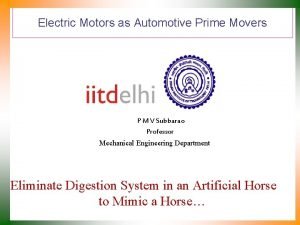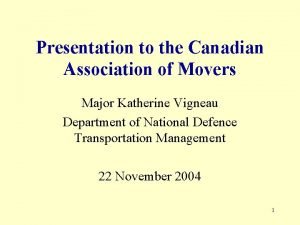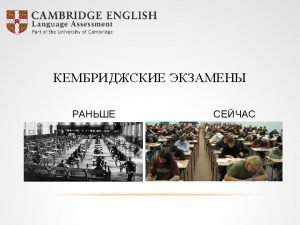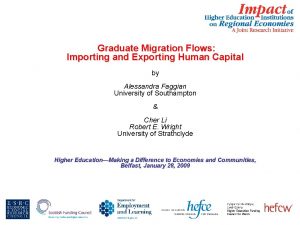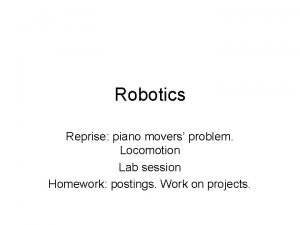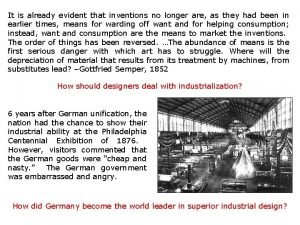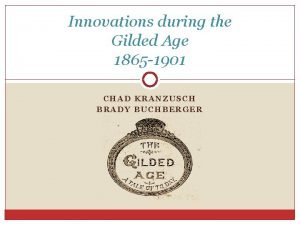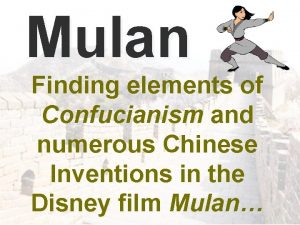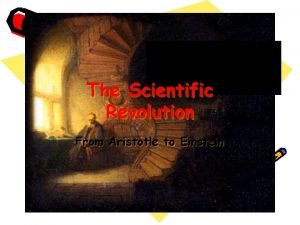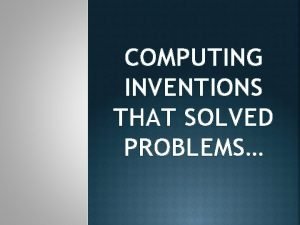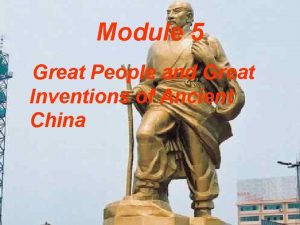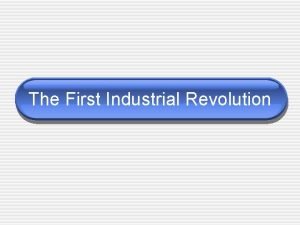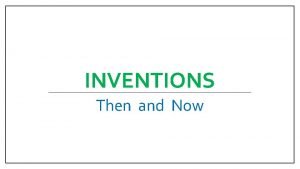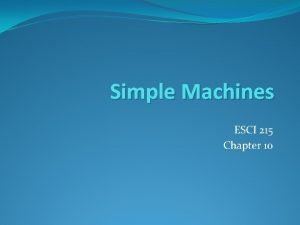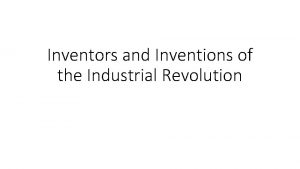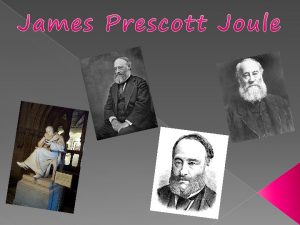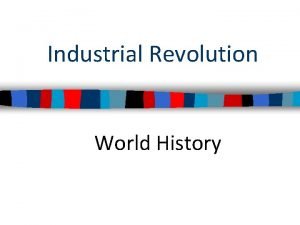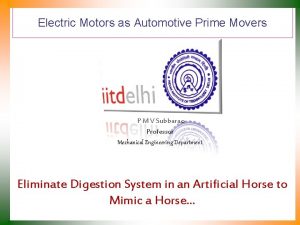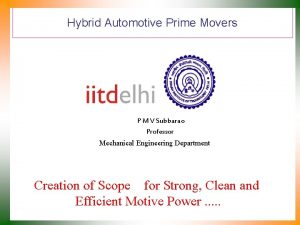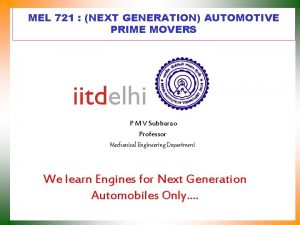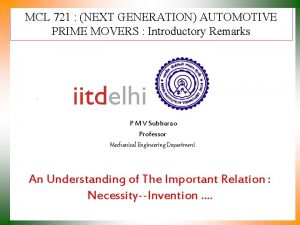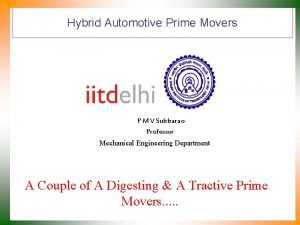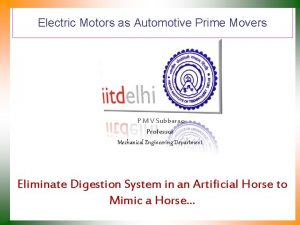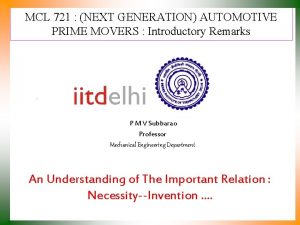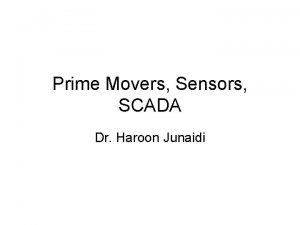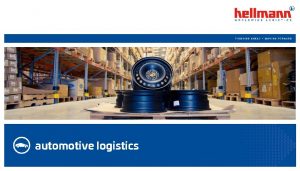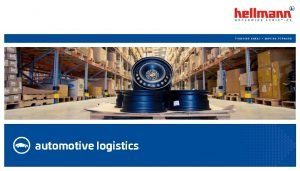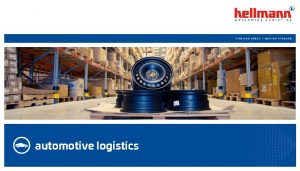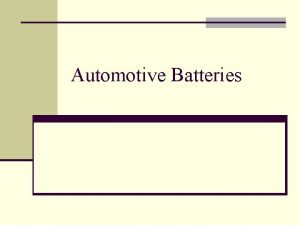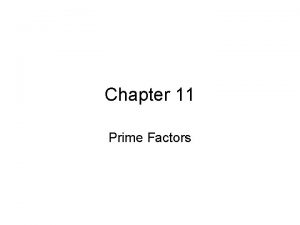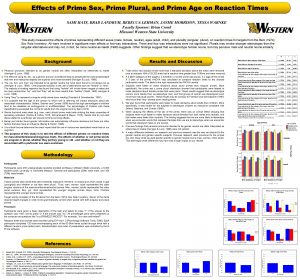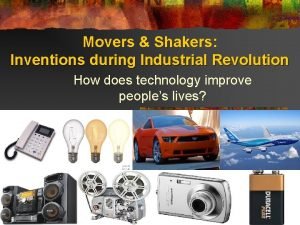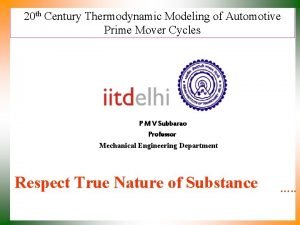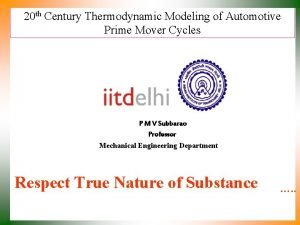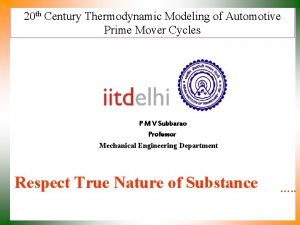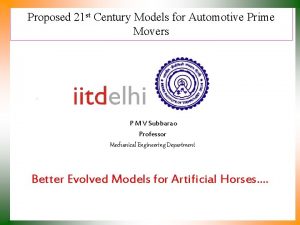20 th Century Inventions for Automotive Prime Movers

































- Slides: 33

20 th Century Inventions for Automotive Prime Movers based on Diesel’s Model P M V Subbarao Professor Mechanical Engineering Department Methods of Building a Rational & Powerful Artificial Horse….

Thermo-chemical Feasibility of Otto’s Model

Thermo-chemical Feasibility of Ignition at Low Loads

Engine Damage From Severe Knock Damage to the engine is caused by a combination of high temperature and high pressure. Piston crown Cylinder head gasket Aluminum cylinder head

Critical Compression Ratio Formula CH 4 C 3 H 8 Name Methane Propane Critical r 12. 6 12. 2

Irrationality of Otto’s Model Typical SI engines 9 < r < 11 k = 1. 4 Fuel/Air Mixture Compression Stroke

Flame Quenching at Wall

Rudolf Christian Karl Diesel • Diesel was born in Paris, France in 1858 the second of three children of Elise and Theodor Diesel. • At age 14, Rudolf wrote a letter to his parents stating that he wanted to become an engineer. • In 1893, He began designing an engine based on the Carnot cycle, and in 1893, Diesel published a treatise entitled Theorie und Konstruktion eines rationellen Wärmemotors zum Ersatz der Dampfmaschine und der heute bekannten Verbrennungsmotoren.

Diesel’s Rational Engine • Theory and Construction of a Rational Heat-engine to Replace the Steam Engine and Combustion Engines Known Today. • This formed the basis for his work on and invention of, the diesel engine. • Eventually he obtained a patent for his design for a compression-ignition engine. In his engine, fuel was injected at the end of compression and the fuel was ignited by the high temperature resulting from compression.

Thermal Efficiency rc=1 rc=2 rc=3 Typical CI Engines 15 < r < 20 When rc (= v 3/v 2) 1 the Diesel cycle efficiency approaches the efficiency of the Otto cycle

Multi Cylinder Diesel engines • 1897 -- Diesel built the first diesel engine at the Augsburg Maschinenfabrik. • 1898 -- Rudolph Diesel, filed a patent application • The single cylinder engine was used to power stationary machinery. • It weighed five tonnes and produced 20 hp at 172 rpm! • The engine operated at 26. 2% efficiency, a very significant improvement on the 20% achieved by the best gasoline engines of the time. • 1922 Benz introduces a 2 -cylinder, 30 hp 800 rpm tractor engine. • 1924 Benz introduces a 4 -cylinder, 50 hp 1000 rpm truck engine. • 1960 - 1970 Peugeot introduced the 404 Diesel followed by the 504 Diesel and the 204 Diesel, the first diesel-powered compact car

The world’s biggest engine : Wärtsilä-Sulzer RTA 96. : May 2015 14 -cylinder, 2 -stroke turbocharged Diesel engine. Weight : 2. 3 million kgs Speed : 102 rpm powering the Emma Maersk It has now become cheaper to transport goods from China to a US port than to transport the same goods from a US port to the final destination inland of US by a truck.

Schematic of Spray Dynamics in Diesel Engine

Why Is It Happening?

Components of Entropy generation mechanisms in CI engines • The Global Entropy generation contains the following subprocesses: • Spray development • Air entrainment and mixing • Droplet evaporation • Auto Ignition • Combustion and thermodynamic Processes • Heat transfer among various parts (Zones) of Cylinder • Formation of Particulates & NOx • Variation of Chemical compositions • Variation of gas properties

Ignition Delay • The sum of times required for sub process preceding the ignition. • The most widely reported correlation relating the ignition delay to the ambient gas condition is given by the relation where τig is the ignition delay, pg and Tg are the ambient gas mean pressure and temperature before autoignition takes place, A, B and n are experimental constants.

Arhenius-type equation for Ignition Delay • An Arhenius type equation for Ignition delay is: p : Premixed air fuel ratio.

Symptoms to be Sensed to Predict Auto Ignition

Effect of Gas Temperature on Ignition Delay

Effect of Equivalence Ratio on Ignition Delay

Temporal Evolutions of Combustion in CI Engine

Direct injection (DI) diesel spray: Spatial distribution

Spatial Variations in CI Engines

Temporal evolution of Combustion in Each Zone Start of injection -20 End of injecction -10 TC 10 20 30

Experimental Study of Combustion Process In above Eq. , the rate of the heat loss Qloss/dθ is expressed as: The convective heat transfer coefficient is given by the Woschni model as For combustion and expansion processes: C 1=0. 00324.

In-cylinder Processes in a Diesel Engine

Dangerous Emissions in CI Engine

Framework To Understand the Occurrence of Danger

Schematic of a diesel spray & flame with temperatures and chemistry

Onset of The Inevitable Danger

Development of Injection Pressure & Injection System in CI Engines

Common Rail Diesel Injection System The Common Rail Diesel Injection System delivers a more controlled quantity of atomised fuel, which leads to better fuel economy; a reduction in exhaust emissions; and a significant decrease in engine noise during operation.

Eco-friendly Equivalence Ratio for CI Combustion
 What is prime mover in mechanical engineering
What is prime mover in mechanical engineering Jeff bezos prime video prime
Jeff bezos prime video prime Canadian association of movers
Canadian association of movers Moverssuite
Moverssuite El cheapo movers
El cheapo movers The primary movers and shakers of the global economy
The primary movers and shakers of the global economy Starters movers flyers ket pet fce cae
Starters movers flyers ket pet fce cae Pengertian stayers dan movers
Pengertian stayers dan movers Joey movers
Joey movers Usaa agent portal
Usaa agent portal Piano movers problem
Piano movers problem First way movers
First way movers Critical thinkers are movers and shakers
Critical thinkers are movers and shakers Ustranscom
Ustranscom English
English Fritz mackensen moormadonna
Fritz mackensen moormadonna Modern age inventions
Modern age inventions Raj reddy inventions
Raj reddy inventions Inventions in communication
Inventions in communication Light bulb gilded age
Light bulb gilded age Harlem renaissance inventions
Harlem renaissance inventions China massage mulan
China massage mulan Newton's first law of motion
Newton's first law of motion Inventions that solved problems
Inventions that solved problems Confucius teachings
Confucius teachings Eli whitney interchangeable parts
Eli whitney interchangeable parts Han dynasty hot air balloon
Han dynasty hot air balloon Benjamin banneker inventions
Benjamin banneker inventions Pictures of inventions
Pictures of inventions Simple machine inventions
Simple machine inventions Transatlantic cable inventor
Transatlantic cable inventor Key inventions of the industrial revolution
Key inventions of the industrial revolution What did james prescott joule discover
What did james prescott joule discover Textile industry inventions
Textile industry inventions
